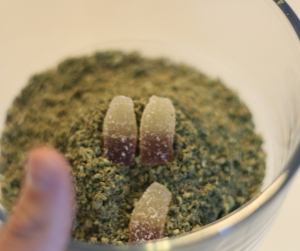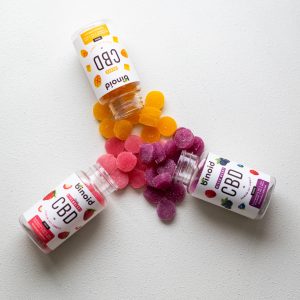
You may have spotted marijuana gummies in your neighborhood cannabis dispensary or candy store. Or perhaps you’ve never heard of them; if that’s the case, you’ll need to be a much heavier smoker than I am before it becomes apparent that you need cannabis edibles.
Cannabinoids are naturally occurring chemicals in the cannabis plant. These chemical compounds interact with the endocannabinoid system, the body’s internal system. Cannabis contains approximately sixty distinct cannabinoids that are believed to have a medicinal effect on the body. Cannabidiol (CBD) is one of these substances, and it is currently being evaluated as an alternative treatment for a variety of illnesses. CBD gummies are popular because they are potent but non-intoxicating and simple to consume. Here’s the Step By Step Guide To Making CBD Infused Edibles
Why create THC Gummies?
The most frequent method of cannabis consumption is smoking, and for good reason. It is simple, enjoyable, and works almost 100% of the time every time. However, comparing smoking marijuana and consuming edibles is analogous to comparing water polo and synchronized swimming, which are both played in pools and are excellent ways to waste a whole afternoon, but are nonetheless quite different sports.
When using edibles, the high might be entirely distinct from smoking. It’s an immersive experience that creates a pleasant, giggly, and frequently euphoric state that may keep you hooked to the couch or giggling at your TV’s screensaver for hours. Due to the fact that edibles can take over an hour to take effect and the high might linger for several hours, they may not be the most convenient kind of everyday high, but make no mistake: they can be well worth it.
Also, if you’re trying to avoid smoking but still want to get high, or if you’re looking for a way to take your medication without stinking up the house, edibles are a delicious and easy alternative.
The Safety of Candies and Other Consumables
Most seasoned eaters of edibles have a tale similar to the one below. I ate the gummy and nothing occurred, then I took more about an hour later, and then it all kicked in and I need you to pick me up.
It can take up to an hour and a half or longer for edibles to take effect, so patience is essential. If you do not feel anything after one hour, relax and wait. You may have a slowed metabolism or a full stomach when you consumed the food. Either way, your best bet when consuming edibles is to begin with a tiny dose or the usual amount, and then to be patient and wait. Note that the cannabis experience and effects of different cannabinoids vary amongst individuals.
Safety should also be considered when creating cannabis candy. To an unknowing child, they will appear and taste virtually identical to conventional gummy bears. To avoid a trip to the emergency room and a call to Child Protective Services, keep your marijuana candies securely sealed and out of the reach of children.
Cannabis Oil
THC and CBD are both fat-soluble, so they must be eaten with fat in order to be digested by the body. THC, CBD, and all other cannabinoids, terpenes, and flavonoids are infused into the cannabis oil mixture, which can then be metabolized by the body.
The best method to prepare edibles is to have your own cannabis infusion on hand, and the majority of THC gummy recipes call for cannabis oil, specifically cannabis-infused coconut oil.
Having cannabis-infused coconut oil on hand ensures that you’re never more than a few steps away from creating your own edibles. And fortunately, infusing cannabis into coconut oil is probably easier than you think.
This recipe calls for less cannabis than other cannabis oil recipes so that the gummies aren’t overly potent, but feel free to adjust the amount based on your tolerance and the THC content of your cannabis.
Decarboxylate a Portion of Cannabis
Decarboxylation is the first and most important step in manufacturing edibles (after obtaining the cannabis, of course). Decarboxylation is a process that activates the cannabis components and transforms THCA to THC, allowing you to become intoxicated. The important element is heat, and all you need to do to decarboxylate your weed is ground it up and bake it for 30 to 45 minutes at 220 to 245 degrees Fahrenheit (105 to 120 degrees Celsius) Just make sure to keep an eye on it so it doesn’t get too hot.
Combine Ingredients on the Stove
After decarboxylating roughly 3.5 grams of cannabis, heat a cup of coconut oil to between 130- and 150-degrees Fahrenheit (55 and 65 degrees Celsius) in a saucepan. Add the cannabis, and boil the mixture for approximately three hours, stirring constantly.
Additionally, a double-boiler may be used. Simply place water in the bottom pan, coconut oil in the top pan, cannabis in the middle, and cook at 130-150°F (55-65°C) for around three hours. Using a slow cooker, simply combine the oil and weed and cook on low for around three hours.
After boiling the oil and cannabis mixture according to the technique you choose, filter the oil to remove the plant residue and store it in a secure location.
How to Make Weed Gummies
If you’ve never manufactured marijuana gummies before, you should be familiar with the term “emulsification.” Cannabis oil can not bond naturally with water or with some of the melted ingredients in gummies, which can result in a distinct layer of cannabis oil in your gummies or gummies that lack the proper consistency. This difficulty can be resolved with an emulsifier such as soy or sunflower lecithin, which will allow the mixture to blend uniformly into the desired gummy consistency.
The majority of pot gummy recipes ask for cannabis oil, but others call for tinctures or other extracts. We will continue to use cannabis oil because it is easier to work with and produce. A second method for emulsifying ingredients is to purée the mixture in a high-powered blender. High-speed agitation will emulsify the ingredients while forming a uniform mixture.
Remember that there is a potency tolerance on your DIY infusions, and you cannot ensure potency without lab testing (the amount of cannabis in your infusions). In legal marketplaces, we feel purchasing cannabis infusions is the safest approach to infuse edibles (oils, tinctures, etc). This ensures that your handmade cannabis-infused edibles are effective.
Alternatively, the following is the most secure way to make homemade cannabis infusions:
First and foremost, gather your stuff. You will require a stove, a saucepan, a whisk, a dropper, a gummy bear mold (or worms, if you want), and a freezer.
Method
Place the pot on the stove over low heat and add the water, cannabis-infused coconut oil, and sunflower/soy lecithin.
Stir until the oil is totally melted and the consistency of the mixture is uniform. Add the flavored and unflavored gelatin while continuously stirring.
Keep on low heat for 10 to 15 minutes, whisking regularly, until the gelatin is dissolved, ensuring that the mixture does not boil.
Using a strainer with a fine mesh, strain the mixture to remove any undissolved gelatin and contaminants.
Fill the gummy molds one by one with a dropper and work rapidly so that the liquid does not cool and separate. Make sure to frequently double back and stir the remaining ingredients so that it does not harden.
Once the mold is full, freeze the gummies for 20 to 25 minutes.
You have successfully created your own cannabis-infused candy. We suggest keeping them in the refrigerator.
How Many CBD Gummies Should you Consume?
The amount of cannabis you consume depends on a variety of things, such as your edibles experience, tolerance, the potency of the cannabis used, and the desired impact. Your best approach, particularly with homemade edibles that may be less accurate than store-bought products, is to begin with a low dose and observe the effects.
It is prudent to be careful and sample a half or perhaps a quarter of a gummy for the first time to determine the potency of your first batch.
If you want a rough approximation of the potency of the gummies, consider the potency of the cannabis oil you used. If you utilized 3.5 grams of cannabis containing 20% THC, each teaspoon of cannabis oil will contain approximately 14mg of THC.
Given that this recipe calls for 12 cup of coconut oil, that equates to 24 teaspoons of oil, and 24 teaspoons with 14mg per teaspoon is 336mg THC for the entire batch of gummies. Given that the recipe calls for 20 small to medium gummy bears, each one contains 16.8mg of THC. If you want each one to be closer to 5mg, use smaller molds and create at least 40 gummies.
With a jar of cannabis gummies stowed at home, you have your own go-to consumable for a winter night on the couch or for zonking out while watching the end of the world in a sweet, gummy embrace. As with any sweet foods that resemble candy, these should be kept out of the reach of children.
Since CBD may be utilized in such a wide variety of ways, you should be able to discover a recipe that suits your needs and tastes. Whether you are seeking chronic pain alleviation or something else, CBD has you covered.
Now that you know how to create marijuana gummies, you no longer need to pay someone else to do so. By producing your own cannabis gummy, you can save money and make a higher-quality product than you can buy in a store, dispensary, or club. You have complete control over the edible cannabis candies, so there are no surprises. Please feel free to contact us if you have any questions or feedback concerning this manual.
 Commercial Gummy Formulation Support
Commercial Gummy Formulation Support


